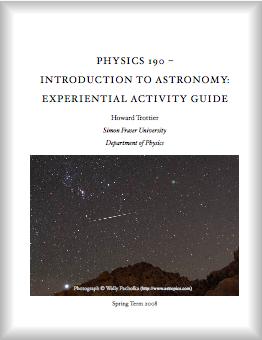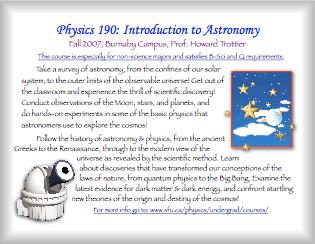Introduction to Astronomy: Experiential Activity Guide
SFU has had an introductory survey course in astronomy for many years (Physics 190: Introduction to Astronomy), which was passionately and expertly taught by Dr. Leigh Palmer, before I took first took on the course in 2003. As at most institutions, we followed a traditional lecture format, with optional evenings of star gazing for interested students.
By 2006 I decided it was time to introduce a formal experiential component to the course. One reason was that SFU was then instituting two new requirements for students in the non-science faculties (such as Arts and Business): a science breadth requirement, and a quantitative analysis requirement. Although the traditional lecture format of an astronomy survey course could easily fulfill both of these requirements, I thought that these new and visionary curriculum changes by SFU provided a golden opportunity to accomplish something equally important, which is to provide non-science students with the experience of actually doing science, at least in a simplified model.
To that end, I designed an experiential component which comprises two parallel sequences, consisting of 4-6 freshman-level physics labs relevant to astronomy, to be done in our undergraduate physics laboratory, and 4-6 naked-eye astronomy observation projects, to be done in the evenings (in part on campus, and in part on the students' own time at a location of their choosing). The lecture sequence was also restructured to make room for some preparatory time and discussion of the laboratory and astronomy projects.
The course has now been offered in this new format, and targeted specifically to non-science students, for 5 semesters (science and engineering students can now only take the course before they complete their first-year labs). I wrote an activity guide for the experiential component of the course, which is distributed at cost. The astronomy projects portion of the activity guide is updated every semester in order to reflect what is currently "up" in the night sky.
The activity guide from a recent offering of the course can be download by clicking the image at the top-left of this page. The guide that is distributed to students includes excerpts from the book 365 Starry Nights by Chet Raymo, which provides a wonderfully impressionistic introduction to the stars, constellations, and history of the naked-eye night sky, for those with no prior knowledge of astronomy; that portion of the activity guide is not reproduced here for copyright reasons (a copyright charge is included in the cost of the manual that is printed by SFU Reprographics for distribution to students during the term).
I've also designed an extensive web site for the course: here is the site from a recent offering of the course.
For scheduling details for Physics 190 consult the physics department's course offerings page.
Finally, I gave a talk on the novel aspects of this course at the 2007 SFU Symposium on Innovative Teaching: the slideshow for this presentation is posted below.
"Q as a tool of Scientific Investigation". This talk, originally given at the 2007 SFU Symposium on Innovative Teaching, reviews experiential activities that I have designed for an Astronomy survey course for non-science students (Physics 190: click here for a flyer on the course). This was given to an audience of non-physics educators, which I split into groups to perform a physics experiment on circular motion (the Newtonian Whirligig)!

